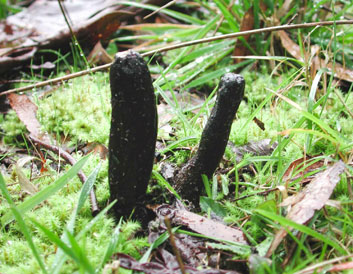 |
Attack of the Killer Mushrooms
Rated PG (Medium level violence)
Starring Cordyceps gunnii, Black Wattle and Wood Moth
You know I always wanted to film a nature documentary. There are some great doco's out there and some, well, are just waiting to be made. This story about some "killer mushrooms" might just be one for David Attenborough. It's got intrigue, violence and sex, in fact it's Mother Nature giving us quite a beautiful and yet horrific natural occurrence. Let me set the scene...
SCENE 1
Early April rains have brought a wide variety of moths fluttering against our windows at night attracted to our internal lights. The ones we are most interested in here are the wood moths. Quite large and resembling Bogongs, the wood moths come under many guises- the swift moth, ghost moth, and wattle goat moth, to name a few. In their larval stage, they all eat wood and some are attracted to wattles.
Some of these red eyed creatures will meet their demise by being devoured by Tawny Frogmouths swooping against our window panes for hours while others have become late night snacks for our dog, Ruby. However, many escape as the main course, and in no time at all, as with most nature docos, sex tends to figure highly in the moths' mind. And as we skip the details, eggs are laid and hatched and small caterpillars begin the next generation by eating their way into mostly black wattle trees (telltale signs: holes drilled in bark or wood; sawdust under bark, etc). The caterpillar eats its way downward into the tree's roots where it grows larger and is reaching the end of its larval stage.
SCENE 2
Meanwhile, as the caterpillar is busy devouring our native flora, something else more sinister is lurking, spreading its web of destruction in the soil near the black wattle roots.
AUTHOR'S DIGRESSION
Many of our older readers will remember that wonderful book (and film) "Day of the Triffids" byJohn Wyndham about a plant species intent on utilising humankind for its main meal (a book that did very little in promoting the sale of venus fly traps). Well, the Triffids spread through the English countryside almost in an exponential rate depending on how many humans they consume. Our main character here, the fungus Cordyceps gunnii, is the underground version of the Triffid, and its web of destruction is its fungal "roots" (official term- mycelium) which began spreading after the autumn rains moistened the soil. Black wattle tends to grow in well drained sites which is also a prime soil type for many of our native fungi. And in fact, these fungal mycelium help many plant species utilise soil nutrients that would otherwise be unavailable to the plant.
SCENE 2 cont.
By now, for those of you who haven't nodded off, the plot thickens... The unsuspecting caterpillar has eaten its way out of the tree's roots so it can start its "metamorphosis" back into a moth. It begins by digging an escape tunnel up to the
surface and then backtracking down refilling the tunnel with sawdust and silk. It then gets comfy at the bottom of the tunnel and begins to metamorphose.
SCENE 3
Unfortunately for the caterpillar, the almost invisible mycelial web has already begun to attack its prey. It enters through the caterpillars' mouth and umm, err, other orifices and basically consumes the caterpillar from the inside out. The weird thing is the caterpillar remains looking like its old self except its body has the consistency of a mushroom stem (which it is!). Quite bizarre really.
With the increased nutrients, the fungi begins to grow its fruiting body using the escape tunnel the caterpillar had built for its own exit. The depth of the caterpillar can vary between 10cm and 40cm deep. The "mushroom" that surfaces is olive green to black in colour and is the shape of a club. As it ages, it becomes brittle and specked grey where it gradually breaks down after releasing its spores.
EPILOGUE
Or maybe it is a sequel to this story since it is almost as interesting. For hundreds, maybe thousands of years, humans have utilized Cordyceps for various illnesses. Traditional Chinese medical practioners have long used cordyceps (species sinensis) for treating ailments like lethargy and impotence. Modern science has found very useful anti viral drugs synthesized from cordyceps as well as immune system enhancers helping to fight leukemia, HIV and hepatitis B.
One paper from Tasmania has even looked at the possibilities of using Cordyceps gunnii (or other species) as a biological control for cockchafer grubs in pastures.
The story continues...
REFERENCES 1. Hamlet et al, "Identifying and Management of Cockchafers and Corbies"; Wool
Profit Program, field day notes June 2005; Tas Dept of Primary Industries. 2. Kearney, Ray & Elma; "Medicinal Properties of Certain Species of Cordyceps";
Sydney Fungal Studies; undated. 3. www.mycolog.com/Clavicipitaceae.htm (magnificent drawings of parasitising fungi) 4. www.bencruachan.org/diary/cordyceps.htm (general over all life cycle guide)
Back to Dr. Tree | Previous article | Next article |











